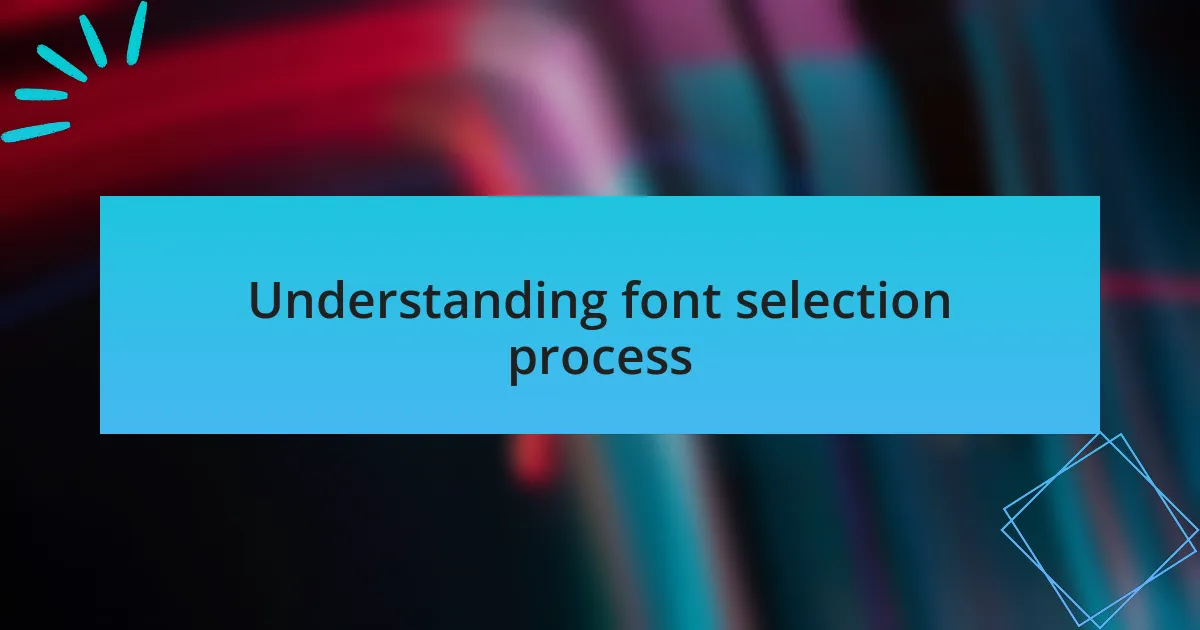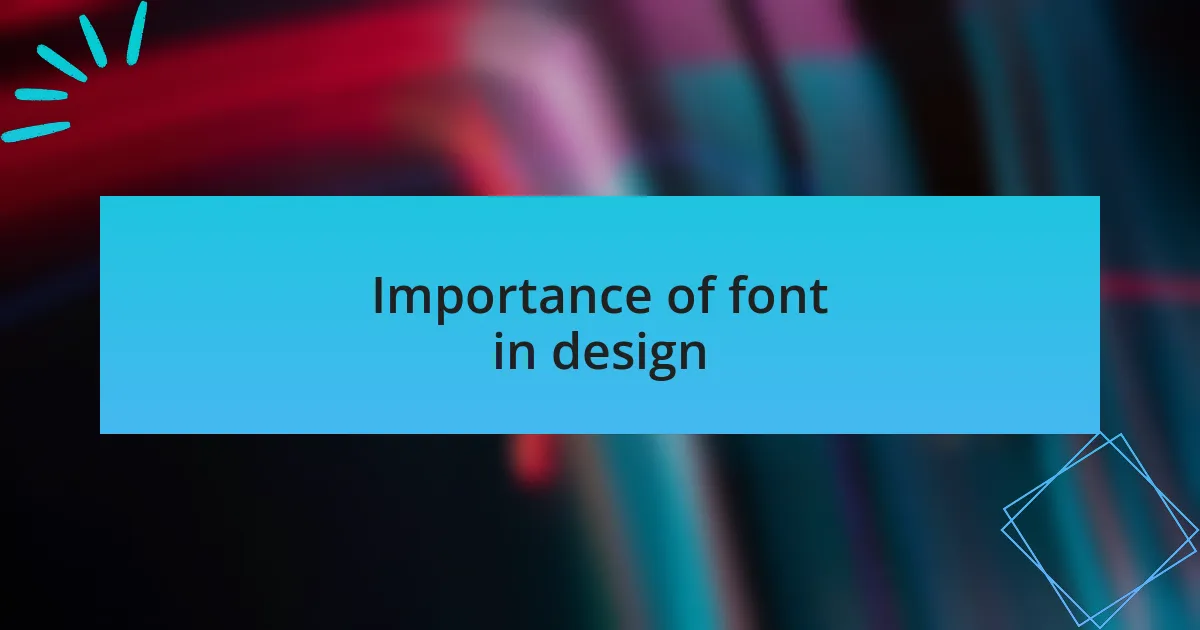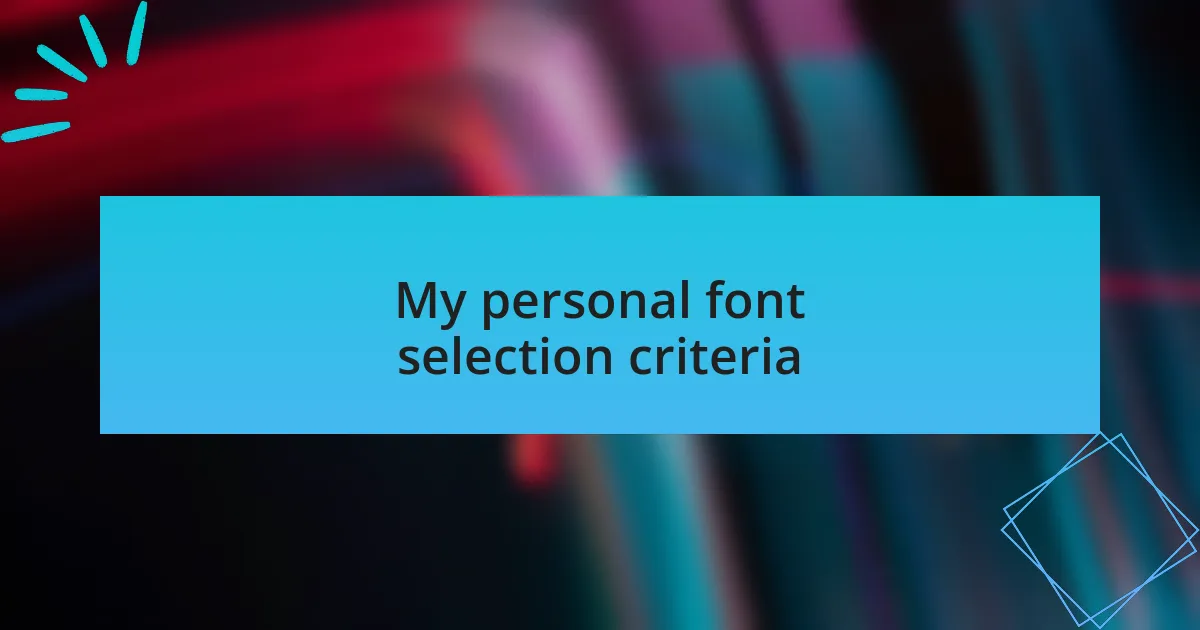Key takeaways:
- Font selection influences emotional tone and brand identity, making readability and scalability essential considerations.
- Different font categories (serif, sans-serif, decorative) serve unique purposes and impact audience perception significantly.
- Online tools like Google Fonts and FontPair streamline the font selection process, aiding in visualizing and pairing fonts effectively.
- Combining fonts effectively requires contrast, hierarchy, and consistency to enhance visual appeal and maintain a cohesive design.

Understanding font selection process
When I start thinking about font selection, the emotional tone of my site comes to mind first. For instance, if I’m designing a brand for a playful children’s toy, I lean towards rounded, fun fonts, whereas a law firm would require something more traditional and authoritative. Have you ever felt the difference a font can make in your perception of a brand? It’s remarkable how much the right font can influence feelings.
Next, I dive into the practicality of my choices. I consider the readability and scalability of a font; is it easy to read on all devices? One time, I chose a trendy font that looked great on a desktop but was a nightmare on mobile. This taught me a valuable lesson about consistency and accessibility—crucial elements in design that can’t be overlooked.
Lastly, I reflect on the brand’s identity. Selecting fonts that resonate with the brand image creates a cohesive narrative. For example, while working on a project for an organic skincare line, I used a handwritten font to evoke authenticity and warmth. Have you ever noticed how some fonts can draw you into a story? It’s an essential part of conveying the right message to the audience.

Importance of font in design
Choosing the right font can truly transform a design’s impact. I remember working on a minimalist website for a tech startup. Initially, I used a sleek, modern font that felt sophisticated, but then I switched to a bolder typeface that delivered confidence and approachability. Instantly, I noticed how much more engaged the audience became. Can you envision how a seemingly small detail like font can shift the entire mood of a project?
Fonts are more than just letters; they bring character and evoke emotions. During a project for an upscale restaurant, I experimented with elegant serif fonts that mirrored the fine dining experience. The feedback was incredible—patrons felt more drawn to the atmosphere just by reading the menu. Isn’t it fascinating how a font can help set the stage for the entire experience of a brand?
Ultimately, the right font harmonizes with the overall design message. In one branding exercise, I paired a classic script font with clean, modern visuals. The combination struck a balance between nostalgia and contemporary design that resonated perfectly with the target audience. Have you experienced the magic that occurs when everything aligns just right in a design? It’s moments like these that remind me of the power fonts hold.

Different types of fonts available
When it comes to the world of typography, you’ll find a rich variety of font categories, each serving a unique purpose. For instance, I often rely on serif fonts for projects that demand tradition and trustworthiness, like when I designed a financial services website. The elegant, finishing strokes in the letters added a touch of sophistication that really resonated with the audience. Have you noticed how a classic font can evoke a sense of reliability?
On the flip side, there are sans-serif fonts that I turn to for a modern and clean aesthetic. I vividly remember a branding campaign for a tech company where I opted for a geometric sans-serif font that felt fresh and approachable. It was amazing to see how this font choice helped communicate innovation and simplicity. How often do we overlook the impact a modern font can have on our perception of a brand?
Then there are decorative fonts, which I see as the playful cousins of typographical choices. I once crafted a promotional piece for a local bakery, using a whimsical script font that mirrored the creativity and fun of their treats. This choice immediately caught the eye and invited curiosity. But it’s important to use these fonts sparingly—would you agree that balance is key in design?

Tools for selecting fonts
When it comes to selecting fonts, I often turn to online tools that simplify the process significantly. One of my favorites is Google Fonts, where I can preview how different typefaces look in my project right away. Have you ever tried adjusting font weights and styles in real time? It really helps me visualize the final result and aligns perfectly with my design vision.
Another resource I value is Adobe Fonts, which offers a vast library of high-quality fonts for various purposes. What I love about Adobe Fonts is the seamless integration with other Adobe products I frequently use. It’s like having a treasure chest of typography at my fingertips, making it easier to maintain a consistent aesthetic across different platforms. Have you found tools that enhance your workflow?
Finally, FontPair is an excellent website for finding font pairings. It’s one of those tools that I’ve used time and again, especially when I’m in a creative slump. I remember a project where I spent hours searching for the perfect complementary fonts. FontPair not only inspired me but also helped me create a harmonious design that drew lots of compliments. How satisfying is it to see your vision come together so effortlessly?

My personal font selection criteria
When it comes to my personal font selection criteria, I prioritize readability above all else. I want my audience to engage with my content easily, so I lean towards fonts that maintain clarity, even at smaller sizes. Have you ever struggled to decipher text on a beautifully designed website? That experience has taught me the importance of choosing fonts that are not just aesthetically pleasing but also user-friendly.
Another aspect I consider is the personality of the font. I often think about the brand’s identity I’m working with—whether it’s modern, vintage, or playful—and select fonts that resonate with that character. There was a recent project for a local café where I chose a handwritten style font that conveyed warmth and approachability. Looking back, it perfectly captured the café’s essence and drew in customers. How does your choice of typography reflect your brand’s voice?
Lastly, I always evaluate how well a font pairs with others. I typically experiment with combinations until I find something that feels balanced. There was one project where I tried different pairings for hours only to land on an unexpected duo that created perfect harmony. It’s moments like that that remind me of the joy found in the creative process. Have you ever stumbled upon the ideal pairing that just works?

Tips for combining fonts effectively
When I’m combining fonts, I often look for contrast to create visual interest. For instance, pairing a bold sans-serif font with a delicate serif can lead to a striking balance. Have you ever noticed how such combinations can instantly elevate the aesthetics of a website? It’s like finding that perfect ingredient that makes a dish pop.
Another approach I take is considering the hierarchy of information. For example, I use a larger, bolder font for headings and a lighter, more subtle font for body text. This method not only guides the reader’s eye but also ensures the content is easy to digest. Have you felt overwhelmed by a wall of text? A clear hierarchy helps prevent that and makes the reading experience much more enjoyable.
I also think about consistency across all design elements. While it’s fun to play with different styles, too many fonts can create chaos. In one project, I learned this the hard way when I experimented too much, and the site ended up looking disjointed. Now, I aim for a maximum of two to three complementary fonts to maintain a cohesive look. What’s your experience with maintaining consistency in typography?